News
Jewels in the Muck
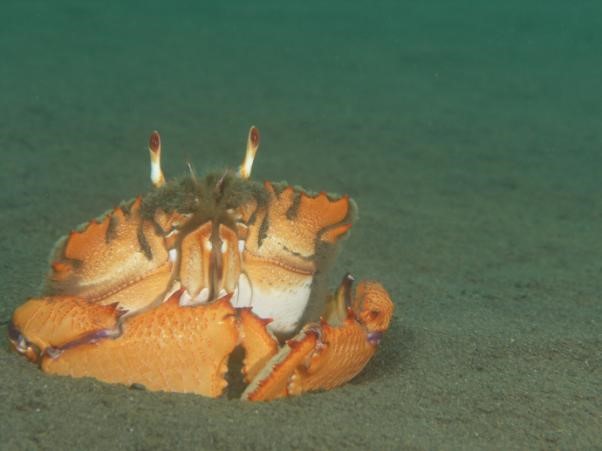
Muck diving in Bali
There is nothing as satisfying as a cup of hot strong sweet black Balinese coffee, served in a glass on the beach after your first muck dive. And there is nothing as astonishing as the critters you find in the old car tyres, empty beer bottles, lost bikini tops and empty foil packets covered in ancient volcanic ash silt.

Adi Assri Resort
This is Muck Diving in Bali. As a spoiled South African Sodwana Bay diver and a confirmed addict of well-balanced reefs, pristine corals and beautiful shoals, I had never realised that there could be a secret thriving world of resourceful marine life in the desert wastes of the undersea world, where tides regularly sweep away their habitat and man provides most of their hiding places.
It was a 10 hour flight on Air Malaysia to Kuala Lumpur, then a short 2.5 hour transfer to Bali, which is 6 hours ahead of South Africa. We paid extra for the VIP Meet and Greet and Border Visa service offered by our Dive Operator and we were whisked through the airport immigration as “crew” and through customs in 5 minutes. The Dive Operator’s air-conditioned mini bus carried us through the ancient Spice Island plantations of cinnamon, nutmeg and cloves, and we arrived at the Adi Assri resort in Gilimanauk, home for our first week. We spent the next day getting used to the new time zone and discovering that fruit and fresh vegetables are very big in Bali, Bintang Beer excellent, and Balinese food is best – Hindu’s are not big on beef, so avoid steaks at all costs. Magnum ice-cream is everywhere. Cash is best from ATMs, not money changers who cheat; plastic accepted in urban areas.
Secret Bay
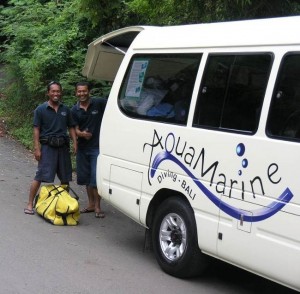
Parman and Wayan
Secret Bay on the North-western tip of Bali is mind-blowingly ugly. Surrounded by mud flats and mangroves with dirty black sand covered in silt deposits, this world famous dive site looked truly awful. It is tidal, so you have to dive it when the tide is rising, or it’s too murky to see. You have to completely change your perception of marine life. It is not all as delicate and fragile as we think. Some of it is tenacious, vigorous and adaptable, and the rarest life forms are found in the most inhospitable places.
We had elected to pay extra for a private dive guide and Parman the dive guide and Wayan the driver were to be our mentors for our entire 25 day stay in Bali.
At the shore entry point there was everything a diver needs – change rooms, showers, cleanish Balinese loos with no paper but a sort of bum-shower arrangement that was a bit disconcerting until one got the hang of it, fresh water troughs where our mentors rinsed the gear, and an ethnic cafe bar where we had lunch, part of the dive package. We kitted up on shore, and sank gently in 28 degree crystal clear water and silt coated rubbish. Finning cautiously to avoid stirring up the silt we drifted down to a maximum depth of 8 metres, scouring the silt for critters.
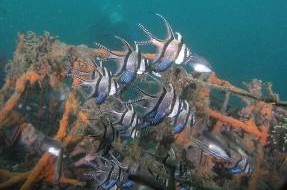
Bangai Damsels
In a pile of discarded burglar guards, we found the first of the muck jewels – a school of Banggai Damsels. Long- spined sea urchins hosted the juveniles, who later graduate to bigger hideouts.
Then Parman found a Mimic Octopus. This was incredible luck, as he is still un-described. He defends himself from predators by mimicking poisonous or unpalatable creatures. He was outraged at being spotted, and quickly reformatted himself into a poisonous brittlestar, hoping he would fool us.
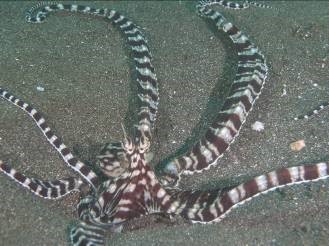
Mimic Octopus
We saw drifts of shrimpfish, bobbing mouth-down as they hoovered up minute particles of food; we saw common and rare seahorse, a plumed shrimp and coral crabs, a juvenile Oriental Sweetlips, schools of batfish, fusiliers and cardinals, both familiar and rare. There were poisonous banded sea-snakes, coiled in hollows, covered in silt and disguised as sea cucumber turds. Our last find was the highly sought after Mandarin fish (Synchiropus Splendidus). He was hiding in a pile of discarded nets, and exquisitely colourful.
Critters are nervous. They can never be sure whether their homes will still be there when they return from feeding, as the plastic bags move with the currents and the tides. It needs a trained eye to spot them and Parman had an amazing knack for finding rare things. We spent 180 minutes underwater over our 2 dives, used up all our air and took 380 photographs. It was one of the most outstanding sites I have ever dived.
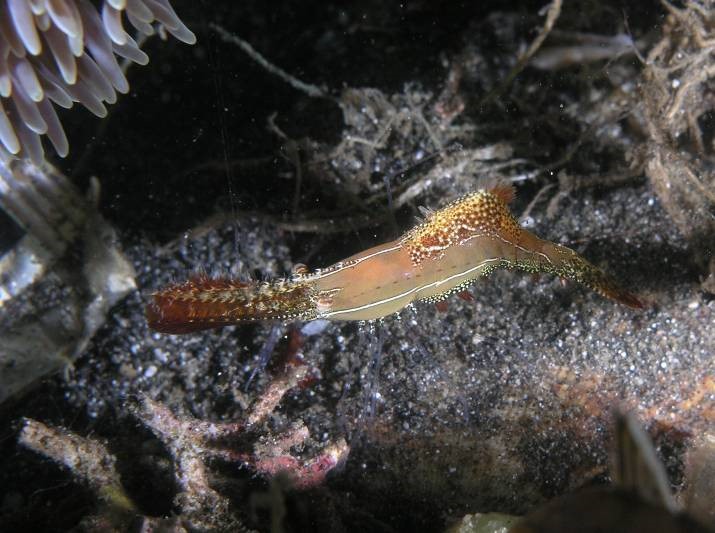
Plumed Shrimp (Leander Piumosus). Rare and gorgeous.
That evening we discovered Bali’s second best secret. There are skilled masseurs all over the island, most hotels and resorts have spas and they all offer Balinese massage. You haven’t lived till you’ve tried one. It costs around R150, lasts an hour or so and creates the most blissfully languid feeling after a hard day’s work lying in warm water looking at beautiful things.
Puri Jati
Spanner Crabs and Snake Eels
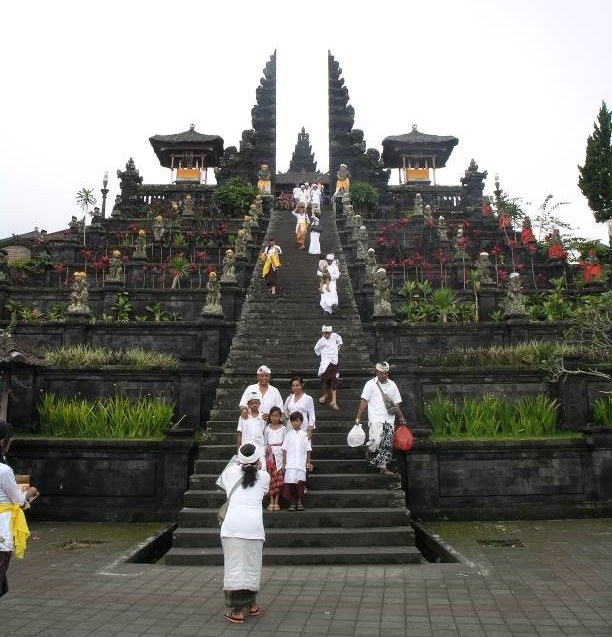
Temples
Our next major dive site was Tulamben where we were to spend another week. On the way we stopped for two dives at Puri Jati, a small Northern coastal farming community, where families cultivate the rice using hysterical little two-wheeled tractors. Wherever we went there were little palm baskets of flowers and rice in miniature temples and on pathways. We enjoyed the flowers, the birds ate the rice. This culture of sharing one’s bounty with others pervades Balinese culture, and makes for a wonderful feeling of harmony on the island. The only Hindu Island in Islamic Indonesia, Bali is volcanic, suffers occasional earthquakes and their Hindu religion pacifies their gods and keeps the volcano quiet. Rice paddy terraces are everywhere, and temples and exotic flower gardens in even the humblest homes.
In Bali, a diver’s most basic needs are met at every dive site. Our gear was carried down to the beach and again, we kitted on the shore. In Bali the men take care of the gear while the women are the porters. We sank into crystal clear water, on strangely round-grained fine sand with very little silt. But this was desert. No rubbish or rubble, nothing but sand.
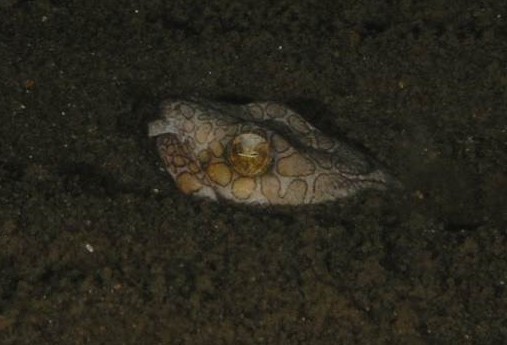
Napoleon Snake Eel (Ophrychthys Bonaparti)
We wandered after Parman, wondering why we were wasting time on this barren place, when his critter hooter sounded and we finned up to him. It was a Pegasus Sea Moth. Rarely spotted, this solitary sand dweller was walking purposefully across the sand on his “feet” – his fused pectoral fins. And right beside it was the most exquisite little creature, swallowing and gasping and finning round in circles – a very juvenile pufferfish, the size of a thumb nail.
As the sandy bottom began to slope we found a mooring rope attached to a pair of old car tyres. Inside was this exquisite, juvenile lion fish right beside the elusive and quite beautiful Ornate Ghost Pipefish. The colours of the stripes were the same on both, and they looked almost as though they had been colour-matched by an interior designer.
The slop began to come alive as we got used to a whole new way of looking at the undersea world. Suddenly we began to notice the minute partner shrimps in the anemones, the strange yellow and brown blobs in the sand that were three types of snake eels. All you could see of them was their snouts and their unblinking eyes, and rare and unusual creatures began to come into focus. There were half a dozen species of lizard fish. There was a drab brown silt covered sea horse that shied away as we approached. There was a minute squat lobster clinging to a sea pen, and a minute red juvenile frogfish.
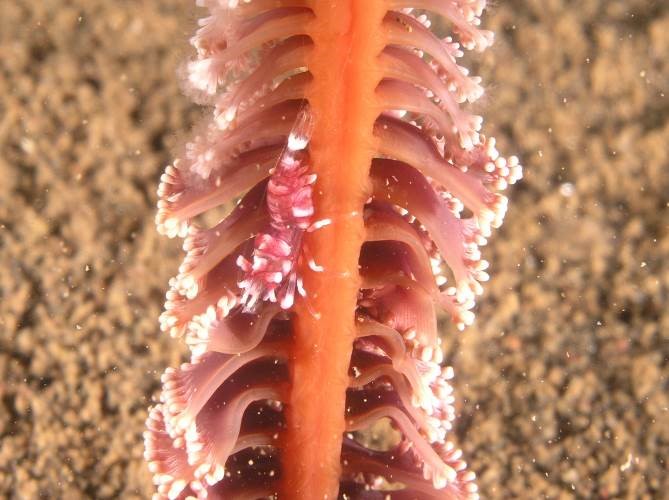
Commensual Sea Pen Shrimp (not identified)
One creature needed no such focus though. He was 15cm across, planted four-square in the sand, hunkered down and immovable, and he made Parman’s day. We were still too unfamiliar with the Bali fauna to know how privileged we were to see him. He normally lies completely buried in sand, and our bible, Ferraris’ book Macrolife has a picture of him. It shows only his eyes and his antennae. He was a Spanner Crab (Ranina ranina), hard to spot, rarely seen, and posing for pictures. Parman’s smile lit up the micro-bus all the way to Tulamben.
Seraya Slope, Tulamben
Soft Silt and Giant Mantis Shrimps
The ash based silt coating the volcanic slope at Seraya, Tulamben was so fine that it was almost impossible to fin anywhere without clouding the water. As we inched cautiously across the rocky slope we noticed some large holes each about 12 centimeters across and beautifully lined with fine vegetable matter. Clearly the architect was a master of materials control, since they remained stable even in the friable silt. We had no idea what could have made them.
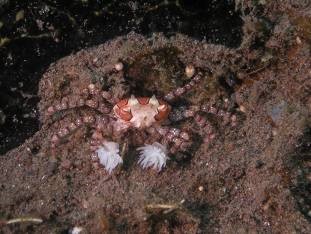
Boxer Crab (Lybia tesselata)
Our first critter was the Boxer Crab (Lybia tesselata). Difficult to find, shy and retiring, he arms the tips of his chelipeds with anemones whose sting protects him from predators. This rare and beautiful crab was out in the open, with his defences raised and a belligerent look on his face. He clearly had no idea how big we were, and was quite willing to fight us off if necessary. There were clumps of stunningly beautiful chrinoids, in every conceivable colour, and amongst them Parman found the Chrinoid squat lobster (Alogalathea elegans). It was not until we identified these two in Macrolife that we realised how rare these sightings were.
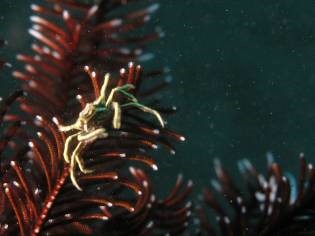
Chrinoid squat lobster (Alogalathea elegans)
As we reached the end of the dive Parman again found one of the mysterious lined holes, and began to scratch around the edges. We peered into the hole, and watched in astonishment as the most amazing creature began to emerge. The size of a rugby ball, it had 2 double eyes, and it looked like a Star Wars android. It was the Giant Mantis Shrimp, (Lysiosquillina lisa) the legendary creature capable of shattering the camera’s Ikelite lens housing. However, it was feeling benevolent, and posed for several photographs before growing bored and ducking back into its hole.
The Balinese people are essentially joyful, good humoured and happy. Thank you we say, you’re welcome, they reply with a smile, and they really mean it. When your world could vanish overnight with an exploding mountain on your doorstep, and an angry sea might threaten a tsunami, you have to be pretty philosophical. And if tourism is your source of revenue in a competitive world, you also have to be pretty cheap.
Bali
How to get there:
Malaysian Airlines
Who to dive with:
Aquamarine Diving is Bali’s only dive operation run by a British woman and is gob-smackingly efficient.
- Air-conditioned Land Transport
- Resort Accommodation
- Diving
- Lunch and Bottled Water
Best of Bali package: 8 days, 14 dives; accommodation included
Best time to travel:
March-October
References and Critter Identification:
- Macrolife by Andrea and Antonella Ferrari
- Fish Guide Indopacific by Helmut Debelius
- Marine Fishes of South East Asia by Gerry Allen
Words: Jill Holloway
Pics: David Holloway
Blogs
Northern Red Sea Reefs and Wrecks Trip Report, Part 3: The Mighty Thistlegorm

Jake Davies boards Ghazala Explorer for an unforgettable Red Sea diving experience…
Overnight, the wind picked up, making the planned morning dive a bit bumpy on the Zodiacs to the drop point on Thomas Reef. There, we would dive along the reef before descending through the canyon and then passing under the arch before ascending the wall with a gentle drift. The site provided great encounters with more pelagic species, including shoals of large barracuda, tuna, and bigeye trevally.
Once back on the boat, it was time to get everything tied down again as we would head back south. This time, with the wind behind us, heading to Ras Mohammed to dive Jackfish Alley for another great gentle drift wall dive before then heading up the coast towards the Gulf of Suez to moor up at the wreck of the Thistlegorm. This being the highlight wreck dive of the trip and for many onboard, including myself, it was the first time diving this iconic wreck. I had heard so much about the wreck from friends, and globally, this is a must on any diver’s list. Fortunately for us, there was only one other boat at the site, which was a rarity. A great briefing was delivered by Ahmed, who provided a detailed background about the wreck’s history along with all the required safety information as the currents and visibility at the site can be variable.

Kitting up, there was a lot of excitement on deck before entering the water and heading down the shoreline. Descending to the wreck, there was a light northerly current which reduced the visibility, making it feel more like the conditions that can be found off the Welsh coast. At 10m from the bottom, the outline of the wreck appeared as we reached the area of the wreck which had been bombed, as our mooring line was attached to part of the propeller shaft. Arriving on deck, instantly everywhere you looked there were many of the supplies which the ship was carrying, including Bren Carrier tanks and projectiles that instantly stood out.

We headed around the exterior, taking a look at the large propeller and guns mounted on deck before entering the wreck on the port side to take a look in the holds. It was incredible to see all the trucks, Norton 16H, and BSA motorcycles still perfectly stacked within, providing a real snapshot in time.

Overall, we had four dives on the Thistlegorm, where for all of the dives we were the only group in the water, and at times, there were just three of us on the whole wreck, which made it even more special, especially knowing that most days the wreck has hundreds of divers. Along with the history of the wreck, there was plenty of marine life on the wreck and around, from big green turtles to batfish, along with shoals of mackerel being hunted by trevally. Some unforgettable dives.

The final leg of the trip saw us cross back over the Suez Canal to the Gobal Islands where we planned to stay the night and do three dives at the Dolphin House for the potential of sharing the dive with dolphins. The site, which included a channel that was teeming with reef fish, especially large numbers of goatfish that swam in large shoals along the edge of the reef. These were nice relaxing dives to end the week. Unfortunately, the dolphins didn’t show up, which was okay as like all marine life they are difficult to predict and you can’t guarantee what’s going to be seen. With the last dive complete, we headed back to port for the final night where it was time to clean all the kit and pack before the departure flight the next day.

The whole week from start to finish on Ghazala Explorer was amazing; the boat had all the facilities you need for a comfortable week aboard. The crew were always there to help throughout the day and the chefs providing top quality food which was required after every dive. The itinerary providing some of the best diving with a nice mixture of wreck and reef dives. I would recommend the trip to anyone, whether it’s your first Red Sea liveaboard in the Red Sea or you’re revisiting. Hopefully, it’s not too long before I head back to explore more of the Red Sea onboard Ghazala Explorer.

To find out more about the Northern Red Sea reef and wrecks itineraries aboard Ghazala Explorer, or to book, contact Scuba Travel now:
Email: dive@scubatravel.com
Tel: +44 (0)1483 411590
Photos: Jake Davies / Avalon.Red
Blogs
Northern Red Sea Reefs and Wrecks Trip Report, Part 2: Wall to Wall Wrecks

Jake Davies boards Ghazala Explorer for an unforgettable Red Sea diving experience…
The second day’s diving was a day full of wreck diving at Abu Nuhas, which included the Chrisoula K, Carnatic, and Ghiannis D. The first dive of the day was onto the Chrisoula K, also known as the wreck of tiles. The 98m vessel remains largely intact where she was loaded with tiles which can be seen throughout the hold. The stern sits at 26m and the bow just below the surface. One of the highlights of the wreck is heading inside and seeing the workroom where the machinery used for cutting the tiles are perfectly intact. The bow provided some relaxing scenery as the bright sunlight highlighted the colours of the soft coral reef and the many reef fish.

Following breakfast, we then headed to the next wreck, which was the Carnatic. The Carnatic is an 89.9m sail steamer vessel that was built in Britain back in 1862. She ran aground on the reef back in 1869 and remains at 27m. At the time, she was carrying a range of items, including 40,000 sterling in gold. An impressive wreck where much of the superstructure remains, and the two large masts lay on the seafloor. The wooden ribs of the hull provide structures for lots of soft corals, and into the stern section, the light beams through, bouncing off the large shoals of glass fish that can be found using the structure as shelter from the larger predators that are found outside of the wreck.

The final wreck at Abu Nuhas was the Ghiannis D, originally called ‘Shoyo Maru,’ which was 99.5m long and built in Japan back in 1969 before becoming a Greek-registered cargo ship in 1980. The ship then ran aground on the reef on April 19th, 1983, and now sits at the bottom at a depth of 27m. Heading down the line, the stern of the ship remains in good condition compared to the rest of the hull. The highlight of the wreck, though, is heading into the stern section and down the flights of stairs to enter the engine room, which remains in good condition and is definitely worth exploring. After exploring the interior section of the ship, we then headed over to see the rest of the superstructure, where it’s particularly interesting to see the large table corals that have grown at the bow relatively quickly considering the date the ship sank. After surfacing and enjoying some afternoon snacks, we made sure everything was strapped down and secured as we would be heading north and crossing the Gulf of Suez, where the winds were still creating plenty of chop.

The next morning, it was a short hop to Ras Mohammed Nature Reserve for the next couple of days of diving. The 6am wake-up call came along with the briefing for the first site we would be diving, which was Shark & Yolanda. The low current conditions allowed us to start the dive at Anemone City, where we would drift along the steep, coral-filled wall. These dives involved drifts, as mooring in Ras Mohammed wasn’t allowed to protect the reefs. As a dive site, Shark & Yolanda is well-known and historically had a lot of sharks, but unfortunately not so many in recent years, especially not so early in the season. However, there was always a chance when looking out into the blue.

The gentle drift took us along the steep walls of the site, with plenty of anemone fish to be seen and a huge variety of corals. It wasn’t long into the dive before we were accompanied by a hawksbill turtle, who drifted with us between the two atolls before parting ways. Between the two reefs, the shallow patch with parts of coral heads surrounded by sand provided the chance to see a few blue-spotted stingrays that were mainly resting underneath the corals and are always a pleasure to see. With this being the morning dive, the early sunlight lit up the walls, providing tranquil moments. Looking out into the blue, there was very little to be seen, but a small shoal of batfish shimmering underneath the sunlight was a moment to capture as we watched them swim by as they watched us.

Towards the end of the dive, we stopped at the wreck of the Jolanda where the seafloor was scattered with toilets from the containers it was carrying. This provided a unique site to make a safety stop, which was also accompanied by a large barracuda slowly swimming by, along with a hawksbill turtle calmly swimming over the reef as the sun rays danced in the distance.
For the next dive, we headed north to the Strait of Tiran to explore the reefs situated between Tiran Island and Sharm El Sheik, which were named after the British divers who had found them. We started on Jackson before heading to Gordons Reef, where we also did the night dive. All the atolls at these sites provided stunning, bustling coral reefs close to the surface and steep walls to swim along, which always provided the opportunity to keep an eye out for some of the larger species that can be seen in the blue. Midwater around Jackson Reef was filled with red-toothed triggerfish and shoals of banner fish, which at times were so dense that you couldn’t see into the blue. Moments went by peacefully as we enjoyed the slow drift above the reef, watching these shoals swim around under the mid-afternoon sun.

The night dive at Gordon’s Reef was mainly among the stacks of corals surrounded by sand, which was great to explore under the darkness. After some time circling the corals, we came across what we were really hoping to find, and that was an octopus hunting on the reef. We spent the majority of the dive just watching it crawl among the reef, blending into its changing surroundings through changes in colour and skin texture. It’s always so fascinating and captivating to watch these incredibly intelligent animals, in awe of their ability to carry out these physical changes to perfectly blend into the reef. Before we knew it, it was time to head back to the boat to enjoy a well-deserved tasty dinner prepared by the talented chefs onboard.
Check in for the 3rd and final part of this series from Jake tomorrow!
To find out more about the Northern Red Sea reef and wrecks itineraries aboard Ghazala Explorer, or to book, contact Scuba Travel now:
Email: dive@scubatravel.com
Tel: +44 (0)1483 411590
Photos: Jake Davies / Avalon.Red
-

 News3 months ago
News3 months agoHone your underwater photography skills with Alphamarine Photography at Red Sea Diving Safari in March
-

 News3 months ago
News3 months agoCapturing Critters in Lembeh Underwater Photography Workshop 2024: Event Roundup
-

 Marine Life & Conservation Blogs2 months ago
Marine Life & Conservation Blogs2 months agoCreature Feature: Swell Sharks
-

 Blogs2 months ago
Blogs2 months agoMurex Resorts: Passport to Paradise!
-

 Blogs2 months ago
Blogs2 months agoDiver Discovering Whale Skeletons Beneath Ice Judged World’s Best Underwater Photograph
-

 Gear Reviews3 months ago
Gear Reviews3 months agoGear Review: Oceanic+ Dive Housing for iPhone
-

 Marine Life & Conservation2 months ago
Marine Life & Conservation2 months agoSave the Manatee Club launches brand new webcams at Silver Springs State Park, Florida
-

 News3 months ago
News3 months agoWorld’s Best Underwater Photographers Unveil Breathtaking Images at World Shootout 2023
















